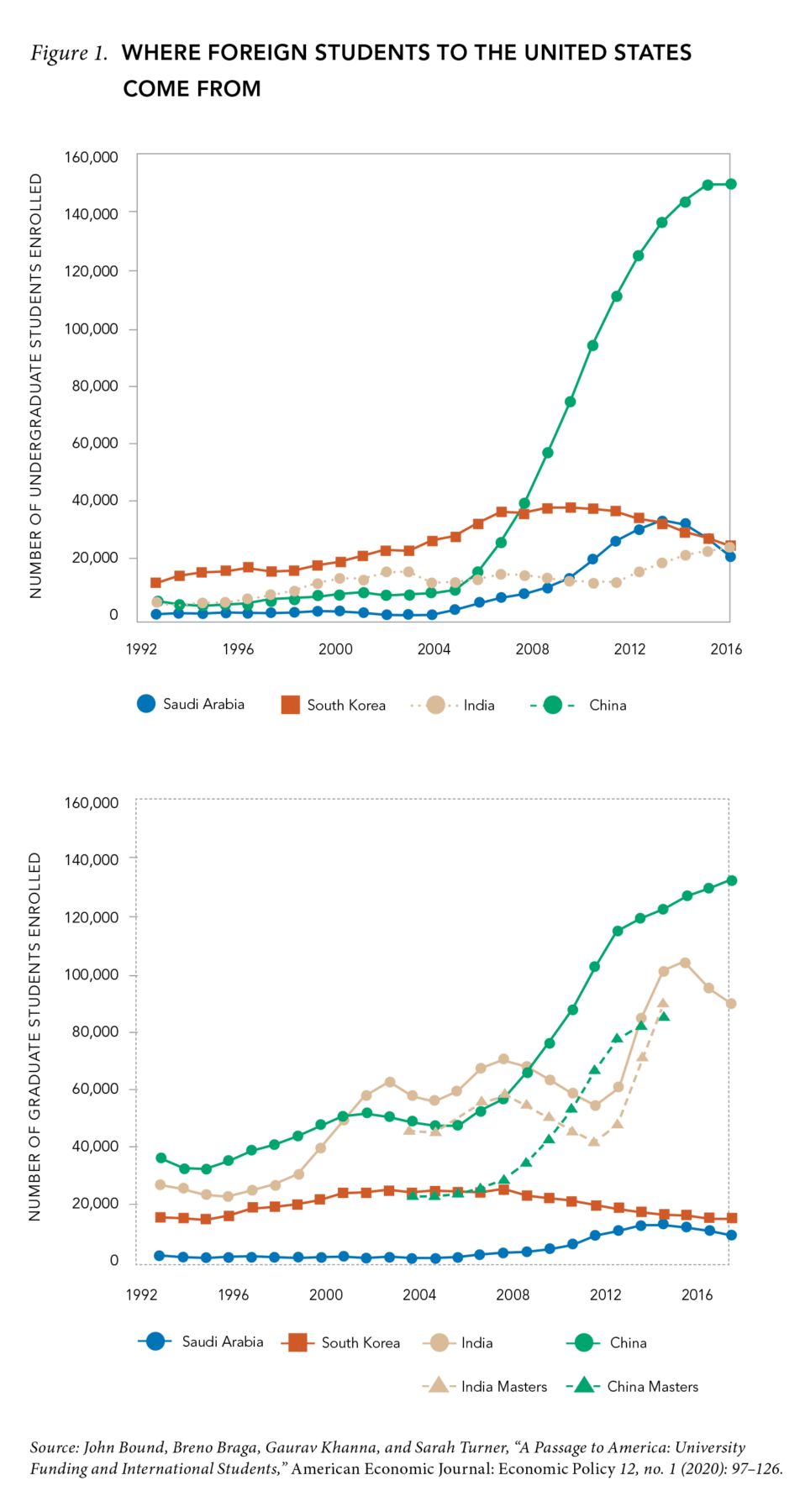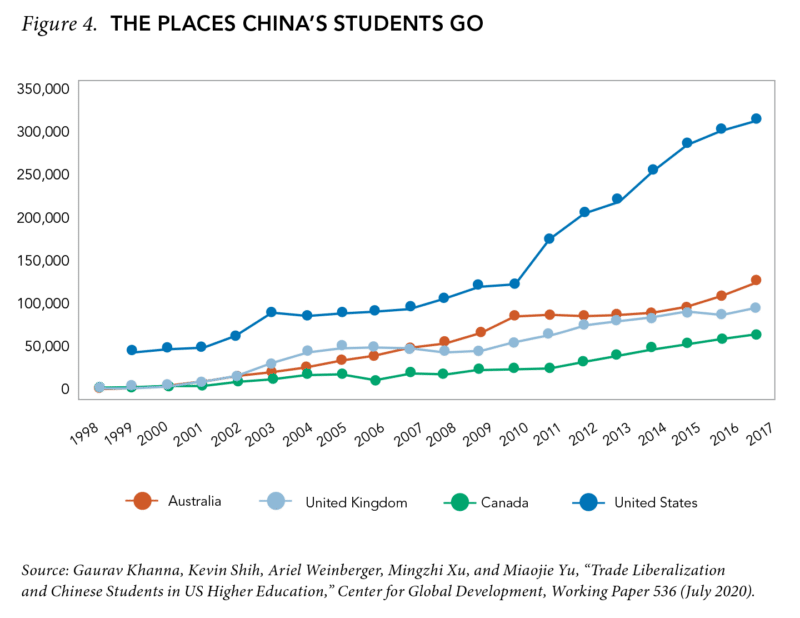How Higher Education Became an Important US Export
Over the last three decades, foreign students have supported the bottom lines of US universities, technology companies, and communities. Now their numbers are plateauing.
The United States became a magnet for foreign students over the last three decades, but the broader interconnected impacts of this shift are not well understood. Between 1980 and 2017, the number of foreign students enrolled in US higher education increased by more than 300%, reaching more than 1 million students, who are disproportionately concentrated in graduate degrees in science, technology, engineering, and math (STEM) fields. The share of undergraduate degrees awarded to international students has also doubled. Over the last five years, however, a number of influences—including changes in US politics, the growth of China’s economy and education system, and increased global competition for foreign talent—have flattened this growth.
The attraction and integration of foreign students, particularly from China and India, transformed the US higher education landscape. US higher education became a major export for the economy, generating $44 billion in revenue in 2019 alone. In addition, universities are often the first stop in a pipeline of STEM talent, as many students transition to jobs in the science and technology sector. For decades, foreign students have been an important source of global talent for the US STEM workforce, as many people first enter the country on student visas.

US universities capitalized on these flows of foreign students, particularly after the financial crisis of 2008, when many schools lost other sources of revenue. To meet funding shortfalls, many universities actively stepped up recruitment efforts and expertly navigated the immigration landscape to attract students from abroad.
Students have been drawn to US universities for a variety of reasons, many of which are linked to demographic and economic trends in the United States and the students’ home countries. The promise of the software boom in the mid-1990s attracted students from India, who were more likely to join the US labor market upon graduation. In the early 2000s, the ability of Chinese families to afford a US education changed dramatically due to increases in economic development and the appreciation of the yuan. This enabled more Chinese families to pay full-fare tuition and send their children abroad at the undergraduate and graduate level. With demand for higher education on the rise, high school graduates in both China and India were looking for collegiate opportunities at a time when higher education systems in their home countries were at capacity.
For students, the university education was only part of the draw; joining the booming technology sector also played an important role. US universities were seen as an important stepping stone for foreign students looking to join the US STEM workforce. As the technology sector grew, so did the demand for a US degree, creating a dynamic relationship among foreign students, universities, and the US tech sector that led to significant spillover effects.
Between 2005 and 2012, revenue from international students helped public research universities withstand the steady decline in state funding for higher education, enabling universities to keep tuitions affordable for native-born students through the 2008 recession. International student revenue even allowed universities to increase expenditures and, for example, expand their STEM-related departments—perhaps improving the quality of US higher education overall.
The ability to attract foreign students made significant differences in how US universities weathered the recession, and universities responded in different ways. Michigan State and the University of Michigan faced similar declines in state funding but took different approaches to international student enrollment. The University of Michigan worked to attract funding from donors, grants, and even out-of-state domestic enrollment. By contrast, between 2004 and 2012, Michigan State looked abroad, increasing the number of foreign students in its freshmen classes sixfold, from 200 to 1,200. Across the country, between 2007 and 2012 public research universities increased freshman foreign undergraduate enrollment by 133% while enrollment of domestic out-of-state students remained mostly unchanged.

Although the strategy of recruiting foreign students was intended to keep these schools afloat, the benefits of integrating international students (and accompanying full-tuition revenues) did even more for local economies. US Bureau of Economic Analysis data show that international students also boost the economies around college towns, spending on rent, automobiles, and other forms of consumption. In 2007 Michigan State estimated that its foreign students contributed $90 million to the local economy.
In the long term, however, the most important consequence of the flow of international students to the United States has been the expansion of the science and technology workforce, as more than a third of foreign-born information technology (IT) workers first entered the United States on a student visa. At a time when American students were far less likely to work in STEM fields than their foreign-born counterparts, this flow fueled a growing industry. At the start of the IT boom in 1994, only 9% of computer scientists in the United States were foreign born, but by 2010 they accounted for more than 20% of a significantly larger US computer science workforce. In places such as California this pipeline of students becoming workers played an important role in driving the tech boom.
After growing rapidly since the early 2000s, the number of international students coming to the United States has plateaued in the last five years. This trend has generated concern among university administrators and the tech industry as their growing pools of talented students and workers diminishes. This presents a particular challenge for second-tier US universities that were previously able to attract high levels of talent.
Observing the successes of US universities, countries including Canada, Australia, and the United Kingdom have taken deliberate action to compete for global talent, such as easing the postgraduation transition to work visas. Meanwhile, China has started investing heavily in their own higher education sector in an attempt to hold on to some of their talented young people. The Chinese government has expanded home-country capacity for both undergraduate and graduate education under their Project 985 and Project 211 programs. In India, the expansion of numerous teaching-heavy Institutes of National Importance may stem the outflow of undergraduates—while producing a stream of high-quality students ready for graduate programs elsewhere.

Changes in the US political landscape may have also contributed to the slowing growth in foreign talent. Political tensions with China and immigration barriers for talented workers may have made the United States a less attractive destination than it used to be. In California, one of the largest destinations for international students, state legislators are drafting policies to cap the number of international students while providing more funding for domestic students.
Slowdowns and diversions of the flow of international students to the United States would naturally affect both US higher education and the economy more broadly. Concern over the magnitude of the impacts is particularly salient given the financial uncertainties introduced by the pandemic over the past year. Colleges and universities would stand to lose much needed revenue at a time of economic crisis, and industry would lose entrepreneurial and STEM talent at a time when there is greater demand for innovation in technology and medicine. During this time of significant economic and policy change, the evolving interconnections between student immigration, economic growth, and technological progress are important reminders of the globalized nature of modern higher education.


